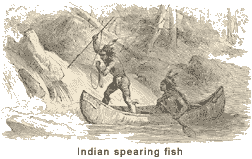The Eastern Woodland Culture consisted of Indian tribes inhabiting the eastern United States and Canada. The Eastern Woodlands were moderate-climate regions roughly from the Atlantic to the Mississippi River and included the Great Lakes. This huge area boasted ample rainfall, numerous lakes and rivers, and great forests. The rich earth and forests from the Ohio River to the Gulf of Mexico comprised the southeastern part of the Eastern Woodlands. This culture region abuts the Plains Culture to the west and the Subarctic Culture to the north.
 The Adena and Hopewell were the earliest historic Eastern Woodland inhabitants. Between 800 B.C. and A.D. 800, they lived in the Ohio and Mississippi river valleys. Both societies are noted for their prominent burial mounds, frequently graced with sophisticated grave goods. Like earlier archaic groups, the Adena were hunters and gatherers who erected seasonal camps. The Hopewell also were hunters and gatherers, but like later Woodland tribes, they lived in villages and supplemented their diet with cultivated plants.
The Adena and Hopewell were the earliest historic Eastern Woodland inhabitants. Between 800 B.C. and A.D. 800, they lived in the Ohio and Mississippi river valleys. Both societies are noted for their prominent burial mounds, frequently graced with sophisticated grave goods. Like earlier archaic groups, the Adena were hunters and gatherers who erected seasonal camps. The Hopewell also were hunters and gatherers, but like later Woodland tribes, they lived in villages and supplemented their diet with cultivated plants.
Later peoples of the Eastern Woodlands included the Illinois, Iroquois, Shawnee and a number of Algonkian-speaking peoples such as the Narragansett and Pequot. Southeastern peoples included the Cherokee, Chocktaw, Chickasaw, Creek, Natchez and Seminole.
Eastern Woodland tribes lived in similar ways. Their complex societies were typically divided into classes, including a chief, his children, the nobility and commoners. Overall there were some variations in climate and harvestable flora and fauna. It followed that the tribes varied somewhat in diet and housing, apparel and transportation.
Since warfare was harsh and frequent, villages were often fortified by fencing reinforced with dirt. Causes of conflict between tribes varied, but typically involved terrritorial rights, male coming-of-age rituals, or retaliation.
In general, the natives were deer-hunters and farmers. The men made bows and arrows, stone knives and war clubs. The women tended garden plots where beans, corn, pumpkin, squash and tobacco were cultivated. Women also harvested these crops and prepared the food. Black pottery or wood and bark vessels were used for cooking. They dried berries, corn, fish, meat and squash for the winter. The diet of deer meat was also supplemented by other game and shellfish.
The tribes lived near water for transportation purposes. In general, the northern tribes fashioned birchbark canoes while southeastern tribes dug out canoes from tree trunks. On land, the natives traveled on foot and bore their cargo on their backs, having no pack animals. Dogs were their sole domesticated animals.
Several sorts of houses were erected throughout the Eastern Woodlands. The most popular was likely the wigwam, a bark-covered structure and the longhouse, home to several families. Some southeast tribes lived in cold-weather houses of clay applied to an armature of poles, complete with a cone or round roof. The Seminoles of Florida used a chikee, a shelter without walls thatched with the palmetto tree's fan-shaped leaves.
Numerous hours were required to fashion the popular deerskin apparel. Women cut the skins with flint knives or shells and sutured them with animal sinew. Face painting and the men's scalp lock (with shaven side hair) were typical.
Beliefs associated with Manitou, a heroic figure who restored the world from mud following terrible rains, were widely held. In the southeast, there were sun worship temples; rites were intricate and featured an altar of fire that was extinguished and re-lighted annually.
The Eastern Woodlands' original inhabitants were the first the European colonists met. From the beginning, the settlers adopted many of the natives' proven methods and paraphernalia, including deerskin clothing.